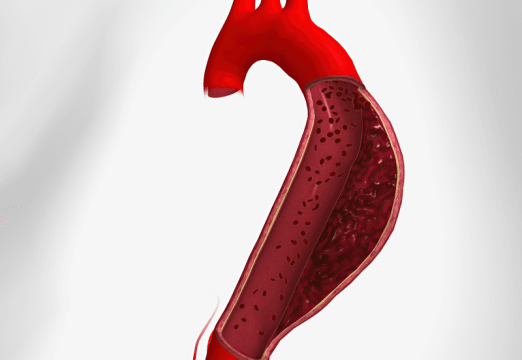Mortality Assessment, Interventions and Hospitalization in Patients with Uncomplicated Type B Aortic Dissection with TEVAR.
Over 60% of type b aortic dissections present with no complications, such as signs of imminent rupture or already established poor perfusion.

Most uncomplicated type b aortic dissections (uTBAD) are managed with medical treatment to control pain and limit the extension of the dissection using anti-impulse therapy, controlling blood pressure and heart beat, to prevent flap extension. Thoracic endovascular repair (TEVAR) is normally reserved to cases presenting complications, or when symptoms are unchecked.
There are clinical situations where TEVAR will be prophylactic, to prevent mortality and late aortic events. However, its role has not been standardized yet by the international guidelines.
The aim of this study was to describe patterns after the use of TEVAR during 30-day hospitalization of patients presenting uncomplicated type B aortic dissection and to compare these against standard medical treatment end points.
This retrospective study looked at Medicare data of patients +65, hospitalized for aortic dissection between 2011 and 2019. It excluded patients with aortic rupture, mal-perfusion, stroke, paraplegia and paresthesia.
Primary end point was all cause mortality, and secondary end points included aortic related hospitalization, aortic intervention and cardiovascular hospitalization.
7105 individual patient data were obtained, 1140 undergoing TEVAR (16%). 54.6% were women. Patients with initial TEVAR were younger (mean age 74 vs 76) and presented fewer comorbidities, such as cardiac failure (9.8% vs 12.7%; P=0.007), valve disease (6.8% vs 9.4%; P=0.006) or frailty (6.3% vs 8.9%; P≤0.001).
39.3% of centers showed low procedure volume (≤11 TEVAR a year).
After inverse probability weighting (IPWE) we see similar mortality with both strategies at one (HR 1.05, IC 95% 0.89-1.24; P=0.58) and 5 years (HR 0.95, CI 95% 0.85-1.06; P=0.36), as well as similar aortic related hospitalization (HR 1.12, CI 95% 0.99-1.27; P=0.08).
Read also: Can Drug Coated Balloon Be a Valid Option for Small Vessels?
After sensitivity analysis including 30-day mortality, initial TEVAR was associated with lower mortality at one (aHR 0.86, CI 95% 0.75-0.99; P=0.03) and five year followup (aHR 0.87, CI 95% 0.80-0.96; P=0.004).
Also, secondary end points showed higher stroke rate in the TEVAR group (2.2% vs 1.2% at one year 7% vs 4.4% at 5 [P≤0.001]).
Conclusions
In this cohort of patients, we see significant morbimortality in aortic dissection patients, with aortic hospitalization (on average 31.4%) and aortic intervention (15.4%) at followup. Looking at primary end point, there were no significant differences in mortality, hospitalization and aortic intervention, which we find after sensitivity analysis.

Dr. Omar Tupayachi.
Member of the Editorial Board of SOLACI.org.
Original Title: Initial Thoracic Endovascular Aortic Repair vs Medical Therapy for Acute Uncomplicated Type B Aortic Dissection.
Reference: Weissler EH, Osazuwa-Peters OL, Greiner MA, Hardy NC, Kougias P, O’Brien SM, Mark DB, Jones WS, Secemsky EA, Vekstein AM, Shalhub S, Mussa FF, Patel MR, Vemulapalli S. Initial Thoracic Endovascular Aortic Repair vs Medical Therapy for Acute Uncomplicated Type B Aortic Dissection. JAMA Cardiol. 2023 Jan 1;8(1):44-53. doi: 10.1001/jamacardio.2022.4187. PMID: 36334259; PMCID: PMC9637274.
Subscribe to our weekly newsletter
Get the latest scientific articles on interventional cardiology





